 | –≠–ª–µ–∫—Ç—Ä–æ–Ω–Ω—ã–π –∫–æ–º–ø–æ–Ω–µ–Ω—Ç: LM4861M | –°–∫–∞—á–∞—Ç—å:  PDF PDF  ZIP ZIP |
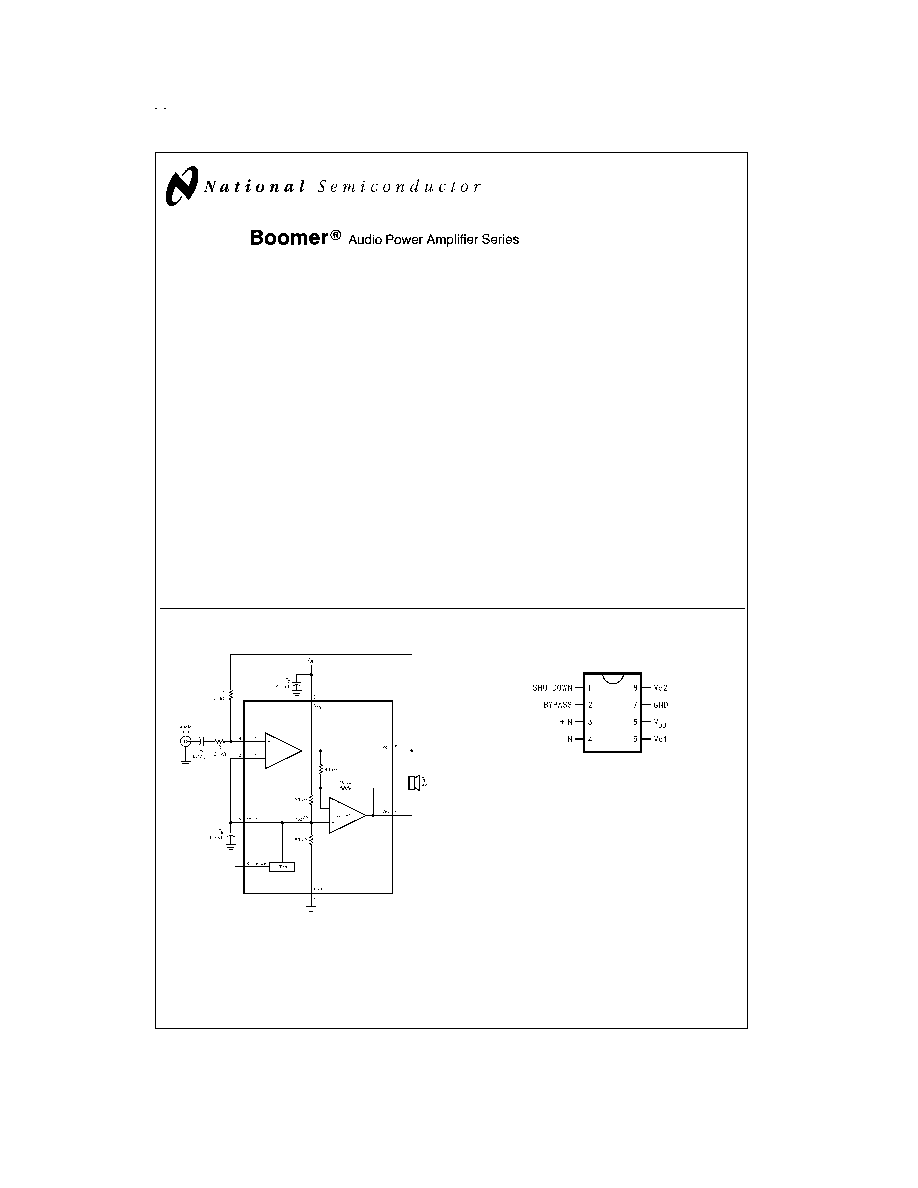
LM4861
1.1W Audio Power Amplifier with Shutdown Mode
General Description
The LM4861 is a bridge-connected audio power amplifier ca-
pable of delivering 1.1W of continuous average power to an
8
load with 1% (THD) using a 5V power supply.
Boomer audio power amplifiers were designed specifically to
provide high quality output power with a minimal amount of
external components using surface mount packaging. Since
the LM4861 does not require output coupling capacitors,
bootstrap capacitors, or snubber networks, it is optimally
suited for low-power portable systems.
The LM4861 features an externally controlled, low-power
consumption shutdown mode, as well as an internal thermal
shutdown protection mechanism.
The unity-gain stable LM4861 can be configured by external
gain-setting resistors.
Key Specifications
n
THD at 1 kHz at 1W continuous
average output power into 8
1.0% (max)
n
Output power at 10% THD+N
at 1 kHz into 8
1.5W (typ)
n
Shutdown Current
0.6 µA (typ)
Features
n
No output coupling capacitors, bootstrap capacitors, or
snubber circuits are necessary
n
Small Outline (SO) packaging
n
Compatible with PC power supplies
n
Thermal shutdown protection circuitry
n
Unity-gain stable
n
External Gain Configuration Capability
Applications
n
Personal computers
n
Portable consumer products
n
Self-powered speakers
n
Toys and games
Typical Application
Connection Diagram
Boomer
Æ
is a registered trademark of National Semiconductor Corporation.
DS011986-1
FIGURE 1. Typical Audio Amplifier Application Circuit
Small Outline Package
DS011986-2
Top View
Order Number LM4861M
See NS Package Number M08A
May 1997
LM4861
1.1W
Audio
Power
Amplifier
with
Shutdown
Mode
© 1999 National Semiconductor Corporation
DS011986
www.national.com
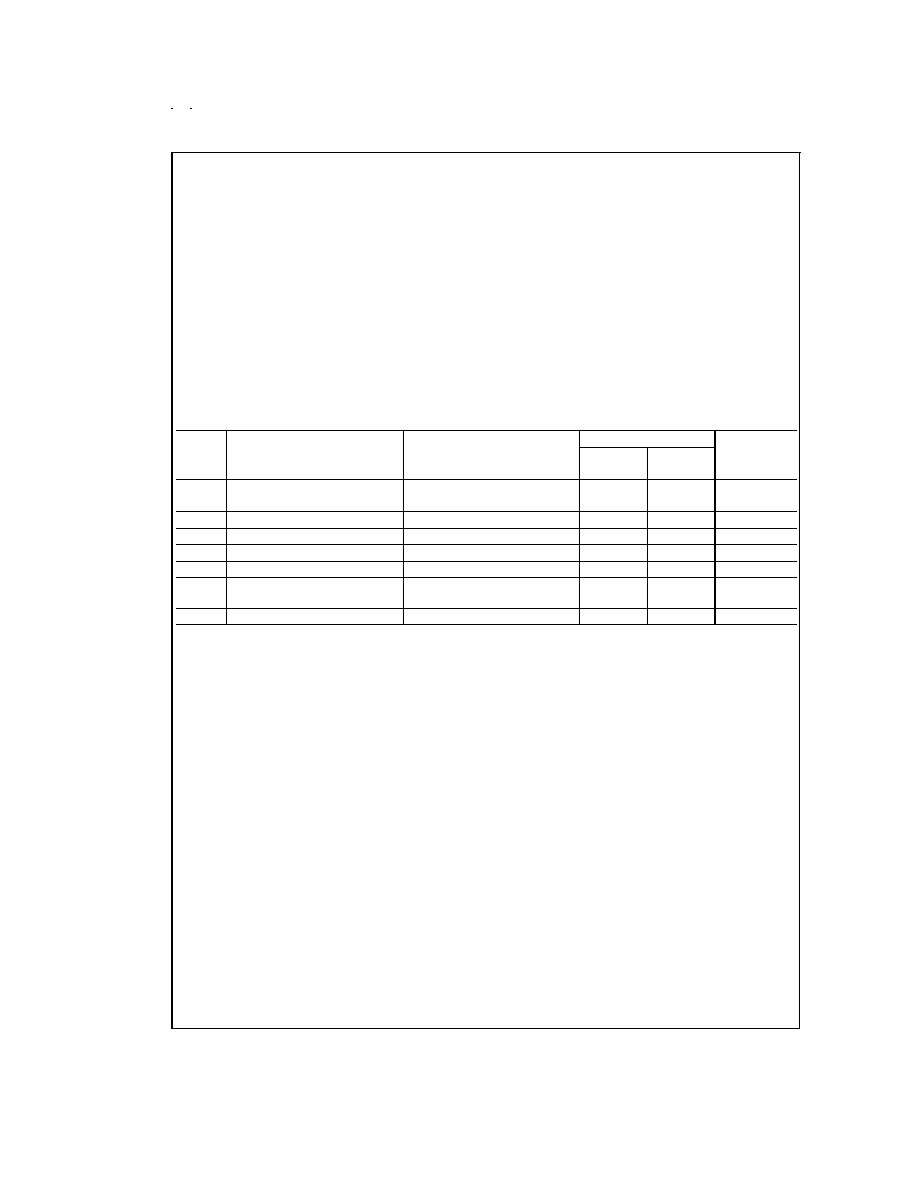
Absolute Maximum Ratings
(Note 2)
If Military/Aerospace specified devices are required,
please contact the National Semiconductor Sales Office/
Distributors for availability and specifications.
Supply Voltage
6.0V
Storage Temperature
-65∞C to +150∞C
Input Voltage
-0.3V to V
DD
+ 0.3V
Power Dissipation (Note 3)
Internally limited
ESD Susceptibility (Note 4)
3000V
ESD Susceptibility (Note 5)
250V
Junction Temperature
150∞C
Soldering Information
Small Outline Package
Vapor Phase (60 sec.)
Infrared (15 sec.)
215∞C
220∞C
See AN-450
"Surface Mounting and their Effects on
Product Reliability" for other methods of soldering surface
mount devices.
Operating Ratings
Temperature Range
T
MIN
T
A
T
MAX
-40∞C
T
A
+85∞C
Supply Voltage
2.0V
V
DD
5.5V
Thermal Resistance
JC
(typ) -- M08A
35∞C/W
JA
(typ) -- M08A
140∞C/W
JC
(typ) -- N08E
37∞C/W
JA
(typ) -- N08E
107∞C/W
Electrical Characteristics
(Note 1) (Note 2)
The following specifications apply for V
DD
= 5V, unless otherwise specified. Limits apply for T
A
= 25∞C.
Symbol
Parameter
Conditions
LM4861
Units
(Limits)
Typical
Limit
(Note 6)
(Note 7)
V
DD
Supply Voltage
2.0
V (min)
5.5
V (max)
I
DD
Quiescent Power Supply Current
V
IN
= 0V, I
O
= 0A (Note 8)
6.5
10.0
mA (max)
I
SD
Shutdown Current
V
pin1
= V
DD
0.6
10.0
µA (max)
V
OS
Output Offset Voltage
V
IN
= 0V
5.0
50.0
mV (max)
P
O
Output Power
THD = 1% (max); f = 1 kHz
1.1
1.0
W (min)
THD+N
Total Harmonic Distortion +
Noise
P
O
= 1Wrms; 20 Hz
f
20 kHz
0.72
%
PSRR
Power Supply Rejection Ratio
V
DD
= 4.9V to 5.1V
65
dB
Note 1: All voltages are measured with respect to the ground pin, unless otherwise specified.
Note 2: Absolute Maximum Ratings indicate limits beyond which damage to the device may occur. Operating Ratings indicate conditions for which the device is func-
tional, but do not guarantee specific performance limits. Electrical Characteristics state DC and AC electrical specifications under particular test conditions which guar-
antee specific performance limits. This assumes that the device is within the Operating Ratings. Specifications are not guaranteed for parameters where no limit is
given, however, the typical value is a good indication of device performance.
Note 3: The maximum power dissipation must be derated at elevated temperatures and is dictated by T
JMAX
,
JA
, and the ambient temperature T
A
. The maximum
allowable power dissipation is P
DMAX
= (T
JMAX
- T
A
)/
JA
or the number given in the Absolute Maximum Ratings, whichever is lower. For the LM4861, T
JMAX
= 150∞C,
and the typical junction-to-ambient thermal resistance, when board mounted, is 140∞C/W.
Note 4: Human body model, 100 pF discharged through a 1.5 k
resistor.
Note 5: Machine Model, 220 pF≠240 pF discharged through all pins.
Note 6: Typicals are measured at 25∞C and represent the parametric norm.
Note 7: Limits are guaranteed to Nationai's AOQL (Average Outgoing Quality Level).
Note 8: The quiescent power supply current depends on the offset voltage when a practical load is connected to the amplifier.
www.national.com
2
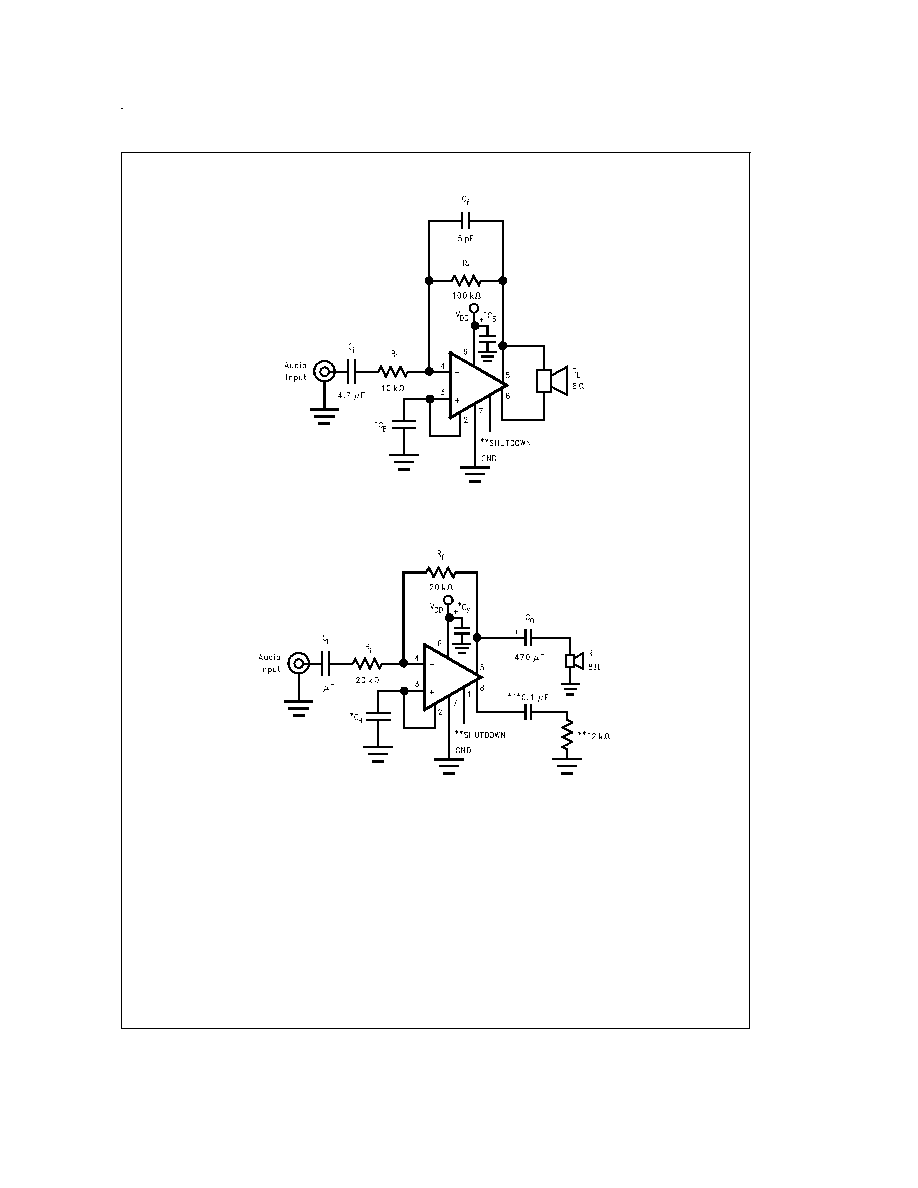
High Gain Application Circuit
Single Ended Application Circuit
DS011986-3
FIGURE 2. Audio Ampiifier with A
VD
= 20
DS011986-4
*C
S
and C
B
size depend on specific application requirements and constraints. Typical vaiues of C
S
and C
B
are 0.1 µF.
**Pin 1 should be connected to V
DD
to disable the amplifier or to GND to enable the amplifier. This pin should not be left floating.
***These components create a "dummy" load for pin 8 for stability purposes.
FIGURE 3. Single-Ended Amplifier with A
V
= -1
www.national.com
3
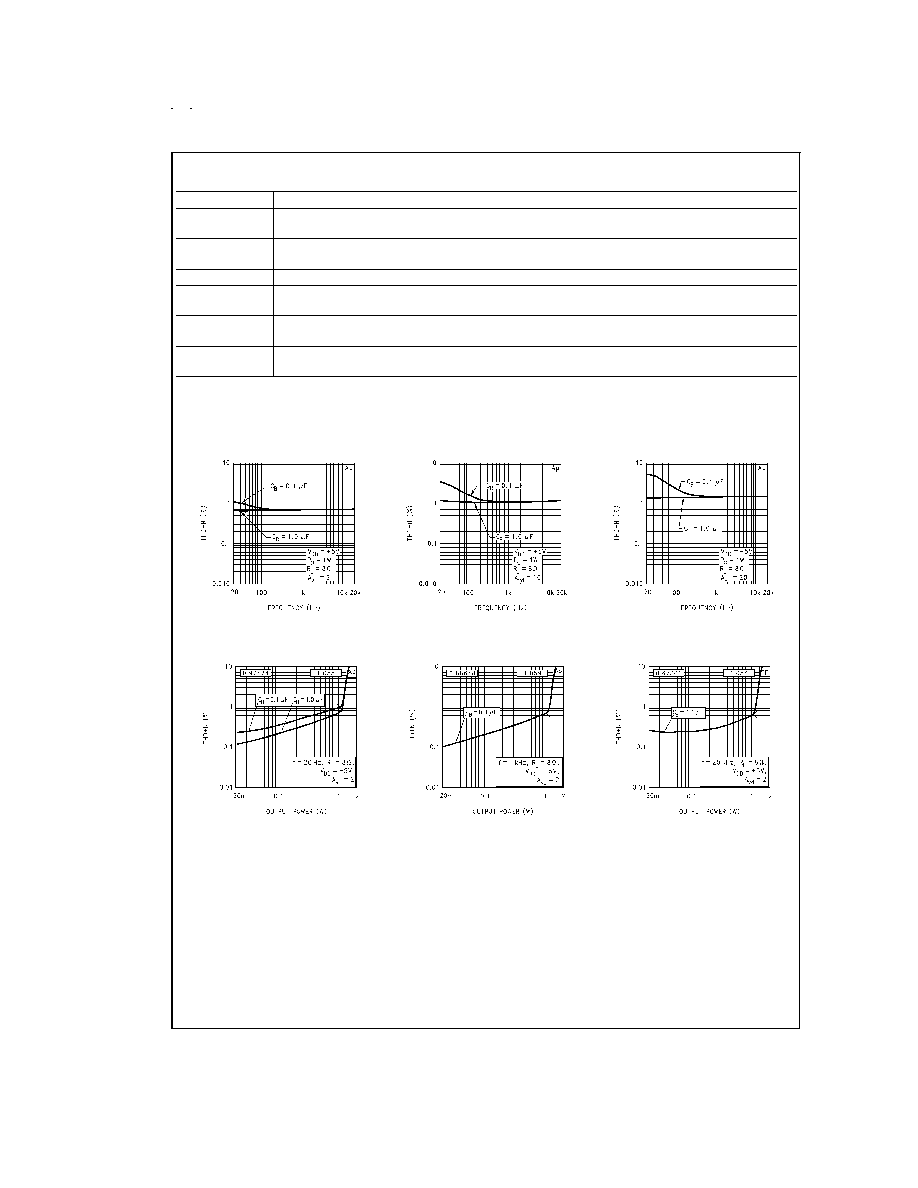
External Components Description
(
Figures 1, 2)
Components
Functional Description
1. R
i
Inverting input resistance which sets the closed-loop gain in conjunction with R
f
. This resistor also forms a
high pass filter with C
i
at f
C
= 1/(2
R
i
C
i
).
2. C
i
Input coupling capacitor which blocks DC voltage at the amplifier's input terminals. Also creates a highpass
filter with R
i
at f
C
= 1/(2
R
i
C
i
).
3. R
f
Feedback resistance which sets closed-loop gain in conjunction with R
i
.
4. C
S
Supply bypass capacitor which provides power supply filtering. Refer to the Application Information
section for proper placement and selection of supply bypass capacitor.
5. C
B
Bypass pin capacitor which provides half supply filtering. Refer to the Application Information section for
proper placement and selection of bypass capacitor.
6. C
f
(Note 9)
C
f
in conjunction with R
f
creates a low-pass filter which bandwidth limits the amplifier and prevents possible
high frequency oscillation bursts.
f
C
= 1/(2
R
f
C
f
)
Note 9: Optional component dependent upon specific design requirements. Refer to the Application Information section for more information.
Typical Performance Characteristics
THD+N vs Frequency
DS011986-5
THD+N vs Frequency
DS011986-6
THD+N vs Frequency
DS011986-7
THD+N vs Output Power
DS011986-8
THD+N vs Output Power
DS011986-9
THD+N vs Output Power
DS011986-10
www.national.com
4
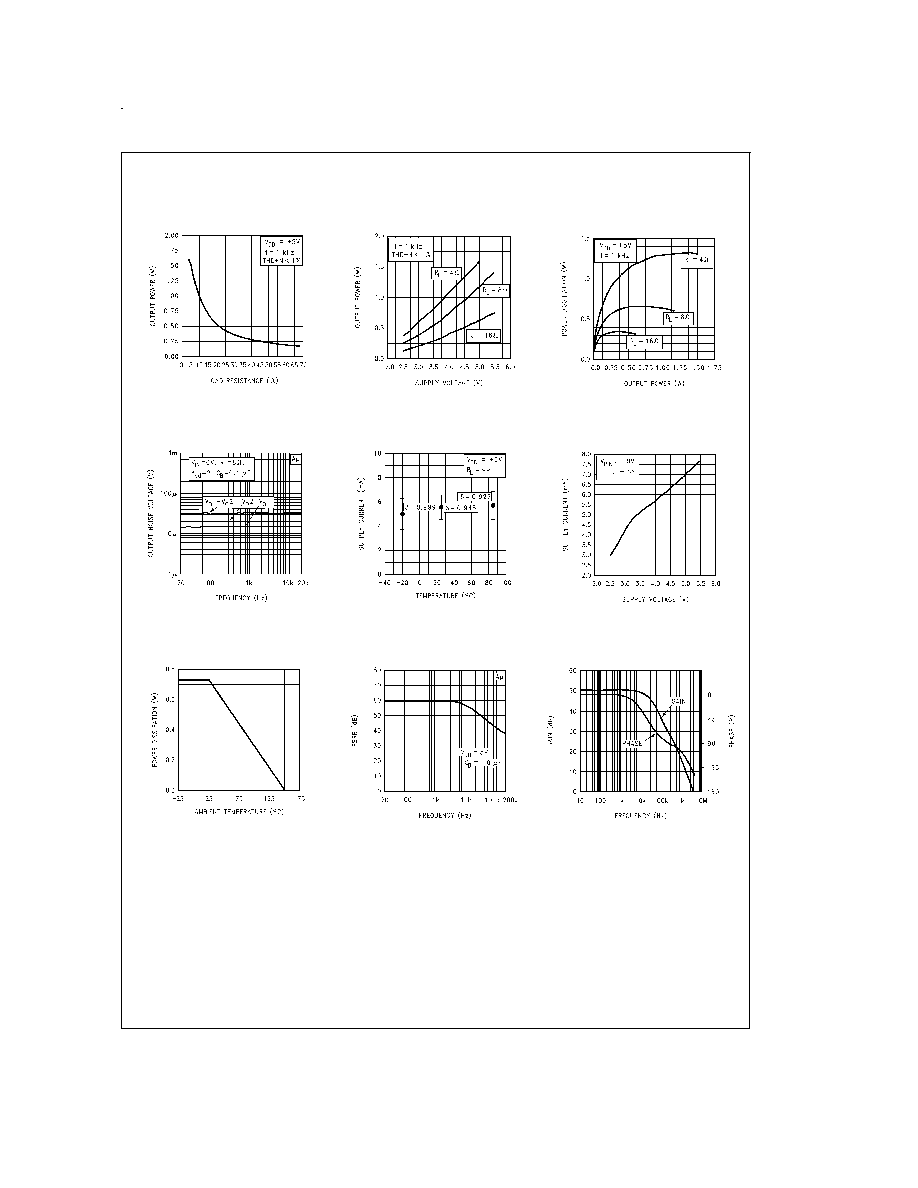
Typical Performance Characteristics
(Continued)
Output Power vs
Load Resistance
DS011986-17
Output Power vs
Supply Voltage
DS011986-18
Power Dissipation vs
Output Power
DS011986-16
Noise Floor vs Frequency
DS011986-14
Supply Current Distribution
vs Temperature
DS011986-15
Supply Current vs
Supply Voltage
DS011986-12
Power Derating Curve
DS011986-13
Power Supply
Rejection Ratio
DS011986-20
Open Loop
Frequency Response
DS011986-19
www.national.com
5

Application Information
BRIDGE CONFIGURATION EXPLANATION
As shown in
Figure 1 , the LM4861 has two operational am-
plifiers internally, allowing for a few different amplifier con-
figurations. The first amplifier's gain is externally config-
urable, while the second amplifier is internally fixed in a
unity-gain, inverting configuration. The closed-loop gain of
the first amplifier is set by selecting the ratio of R
f
to R
i
while
the second amplifier's gain is fixed by the two internal 40 k
resistors.
Figure 1 shows that the output of amplifier one
serves as the input to amplifier two which results in both am-
plifiers producing signals identical in magnitude, but out of
phase 180∞. Consequently, the differential gain for the IC is:
A
vd
= 2 * (R
f
/R
i
)
By driving the load differentially through outputs V
O1
and
V
O2
, an amplifier configuration commonly referred to as
"bridged mode" is established. Bridged mode operation is
different from the classical single-ended amplifier configura-
tion where one side of its load is connected to ground.
A bridge amplifier design has a few distinct advantages over
the single-ended configuration, as it provides differential
drive to the load, thus doubling output swing for a specified
supply voltage. Consequently, four times the output power is
possible as compared to a single-ended amplifier under the
same conditions. This increase in attainable output power
assumes that the amplifier is not current limited or clipped. In
order to choose an amplifier's closed-loop gain without caus-
ing excessive clipping which will damage high frequency
transducers used in loudspeaker systems, please refer to
the Audio Power Amplifier Design section.
A bridge configuration, such as the one used in Boomer Au-
dio Power Amplifiers, also creates a second advantage over
single-ended amplifiers. Since the differential outputs, V
O1
and V
O2
, are biased at half-supply, no net DC voltage exists
across the load. This eliminates the need for an output cou-
pling capacitor which is required in a single supply, single-
ended amplifier configuration. Without an output coupling ca-
pacitor in a single supply, single-ended amplifier, the half-
supply bias across the load would result in both increased
internal IC power dissipation and also permanent loud-
speaker damage. An output coupling capacitor forms a high
pass filter with the load requiring that a large value such as
470 µF be used with an 8
load to preserve low frequency
response. This combination does not produce a flat re-
sponse down to 20 Hz, but does offer a compromise be-
tween printed circuit board size and system cost, versus low
frequency response.
POWER DISSIPATION
Power dissipation is a major concern when designing a suc-
cessful amplifier, whether the amplifier is bridged or single-
ended. A direct consequence of the increased power deliv-
ered to the load by a bridge amplifier is an increase in
internal power dissipation. Equation 1 states the maximum
power dissipation point for a bridge amplifier operating at a
given supply voltage and driving a specified output load.
P
DMAX
= 4*(V
DD
)
2
/(2
2
R
L
)
(1)
Since the LM4861 has two operational amplifiers in one
package, the maximum internal power dissipation is 4 times
that of a single-ended amplifier. Even with this substantial in-
crease in power dissipation, the LM4861 does not require
heatsinking. From Equation 1, assuming a 5V power supply
and an 8
load, the maximum power dissipation point is
625 mW.The maximum power dissipation point obtained
from Equation 1 must not be greater than the power dissipa-
tion that results from Equation 2:
P
DMAX
= (T
JMAX
- T
A
)/
JA
(2)
For the LM4861 surface mount package,
JA
= 140∞C/W and
T
JMAX
= 150∞C. Depending on the ambient temperature, T
A
,
of the system surroundings, Equation 2 can be used to find
the maximum internal power dissipation supported by the IC
packaging. If the result of Equation 1 is greater than that of
Equation 2, then either the supply voltage must be de-
creased or the load impedance increased. For the typical ap-
plication of a 5V power supply, with an 8
load, the maxi-
mum ambient temperature possible without violating the
maximum junction temperature is approximately 62.5∞C pro-
vided that device operation is around the maximum power
dissipation point. Power dissipation is a function of output
power and thus, if typical operation is not around the maxi-
mum power dissipation point, the ambient temperature can
be increased. Refer to the Typical Performance Character-
istics curves for power dissipation information for lower out-
put powers.
POWER SUPPLY BYPASSING
As with any power amplifier, proper supply bypassing is criti-
cal for low noise performance and high power supply rejec-
tion. The capacitor location on both the bypass and power
supply pins should be as close to the device as possible. As
displayed in the Typical Performance Characteristics sec-
tion, the effect of a larger half supply bypass capacitor is im-
proved low frequency THD + N due to increased half-supply
stability. Typical applications employ a 5V regulator with
10 µF and a 0.1 µF bypass capacitors which aid in supply
stability, but do not eliminate the need for bypassing the sup-
ply nodes of the LM4861. The selection of bypass capaci-
tors, especially C
B
, is thus dependant upon desired low fre-
quency THD + N, system cost, and size constraints.
SHUTDOWN FUNCTION
In order to reduce power consumption while not in use, the
LM4861 contains a shutdown pin to externally turn off the
amplifier's bias circuitry. The shutdown feature turns the am-
plifier off when a logic high is placed on the shutdown pin.
Upon going into shutdown, the output is immediately discon-
nected from the speaker. A typical quiescent current of
0.6 µA results when the supply voltage is applied to the shut-
down pin. In many applications, a microcontroller or micro-
processor output is used to control the shutdown circuitry
which provides a quick, smooth transition into shutdown. An-
other solution is to use a single-pole, single-throw switch that
when closed, is connected to ground and enables the ampli-
fier. If the switch is open, then a soft pull-up resistor of 47 k
will disable the LM4861. There are no soft pull-down resis-
tors inside the LM4861, so a definite shutdown pin voltage
must be applied externally, or the internal logic gate will be
left floating which could disable the amplifier unexpectedly.
HIGHER GAIN AUDIO AMPLIFIER
The LM4861 is unity-gain stable and requires no external
components besides gain-setting resistors, an input coupling
capacitor, and proper supply bypassing in the typical appli-
cation. However, if a closed-loop differential gain of greater
than 10 is required, a feedback capacitor may be needed, as
shown in
Figure 2, to bandwidth limit the amplifier. This feed-
back capacitor creates a low pass filter that eliminates pos-
sible high frequency oscillations. Care should be taken when
calculating the -3 dB frequency in that an incorrect combina-
www.national.com
6

Application Information
(Continued)
tion of R
f
and C
f
will cause rolloff before 20 kHz. A typical
combination of feedback resistor and capacitor that will not
produce audio band high frequency rolloff is R
f
= 100 k
and
C
f
= 5 pF. These components result in a -3 dB point of ap-
proximately 320 kHz. Once the differential gain of the ampli-
fier has been calculated, a choice of R
f
will result, and C
f
can
then be calculated from the formula stated in the External
Components Description section.
VOICE-BAND AUDIO AMPLIFIER
Many applications, such as telephony, only require a voice-
band frequency response. Such an application usually re-
quires a flat frequency response from 300 Hz to 3.5 kHz. By
adjusting the component values of
Figure 2, this common
application requirement can be implemented. The combina-
tion of R
i
and C
i
form a highpass filter while R
f
and C
f
form a
lowpass filter. Using the typical voice-band frequency range,
with a passband differential gain of approximately 100, the
following values of R
i
, C
i
, R
f
, and C
f
follow from the equa-
tions stated in the External Components Description sec-
tion.
R
i
= 10 k
, R
f
= 510k ,C
i
= 0.22 µF, and C
f
= 15 pF
Five times away from a -3 dB point is 0.17 dB down from the
flatband response. With this selection of components, the re-
sulting -3 dB points, f
L
and f
H
, are 72 Hz and 20 kHz, re-
spectively, resulting in a flatband frequency response of bet-
ter than
±
0.25 dB with a rolloff of 6 dB/octave outside of the
passband. If a steeper rolloff is required, other common
bandpass filtering techniques can be used to achieve higher
order filters.
SINGLE-ENDED AUDIO AMPLIFIER
Although the typical application for the LM4861 is a bridged
monoaural amp, it can also be used to drive a load single-
endedly in applications, such as PC cards, which require that
one side of the load is tied to ground.
Figure 3 shows a com-
mon single-ended application, where V
O1
is used to drive the
speaker. This output is coupled through a 470 µF capacitor,
which blocks the half-supply DC bias that exists in all single-
supply amplifier configurations. This capacitor, designated
C
O
in
Figure 3, in conjunction with R
L
, forms a highpass filter.
The -3 dB point of this high pass filter is 1/(2
R
L
C
O
), so care
should be taken to make sure that the product of R
L
and C
O
is large enough to pass low frequencies to the load. When
driving an 8
load, and if a full audio spectrum reproduction
is required, C
O
should be at least 470 µF. V
O2
, the output
that is not used, is connected through a 0.1 µF capacitor to
a 2 k
load to prevent instability. While such an instability will
not affect the waveform of V
O1
, it is good design practice to
load the second output.
AUDIO POWER AMPLIFIER DESIGN
Design a 1W / 8
Audio Amplifier
Given:
Power Output
1 Wrms
Load Impedance
8
Input Level
1 Vrms
Input Impedance
20 k
Bandwidth
100 Hz≠20 kHz
±
0.25 dB
A designer must first determine the needed supply rail to ob-
tain the specified output power. By extrapolating from the
Output Power vs Supply Voltage graph in the Typical Per-
formance Characteristics section, the supply rail can be
easily found. A second way to determine the minimum sup-
ply rail is to calculate the required V
opeak
using Equation 3
and add the dropout voltage. Using this method, the mini-
mum supply voltage would be (V
opeak
+ V
OD
, where V
OD
is
typically 0.6V.
(3)
For 1W of output power into an 8
load, the required V
opeak
is 4.0V. A minumum supply rail of 4.6V results from adding
V
opeak
and V
od
. But 4.6V is not a standard voltage that exists
in many applications and for this reason, a supply rail of 5V
is designated. Extra supply voltage creates dynamic head-
room that allows the LM4861 to reproduce peaks in excess
of 1Wwithout clipping the signal. At this time, the designer
must make sure that the power supply choice along with the
output impedance does not violate the conditions explained
in the Power Dissipation section.
Once the power dissipation equations have been addressed,
the required differential gain can be determined from Equa-
tion 4.
(4)
R
f
/R
i
= A
VD
/2
(5)
From equation 4, the minimum A
vd
is 2.83: A
vd
= 3
Since the desired input impedance was 20 k
, and with a
A
vd
of 3, a ratio of 1:1.5 of R
f
to R
i
results in an allocation of
R
i
= 20 k
, R
f
= 30 k
. The final design step is to address
the bandwidth requirements which must be stated as a pair
of -3 dB frequency points. Five times away from a -3 db
point is 0.17 dB down from passband response which is bet-
ter than the required
±
0.25 dB specified. This fact results in
a low and high frequency pole of 20 Hz and 100 kHz respec-
tively. As stated in the External Components section, R
i
in
conjunction with C
i
create a highpass filter.
C
i
1 / (2
*20 k
*20 Hz) = 0.397 µF; use 0.39 µF.
The high frequency pole is determined by the product of the
desired high frequency pole, f
H
, and the differential gain, A
vd
.
With a A
vd
= 2 and f
H
= 100 kHz, the resulting GBWP =
100 kHz which is much smaller than the LM4861 GBWP of
4 MHz. This figure displays that if a designer has a need to
design an amplifier with a higher differential gain, the
LM4861 can still be used without running into bandwidth
problems.
www.national.com
7
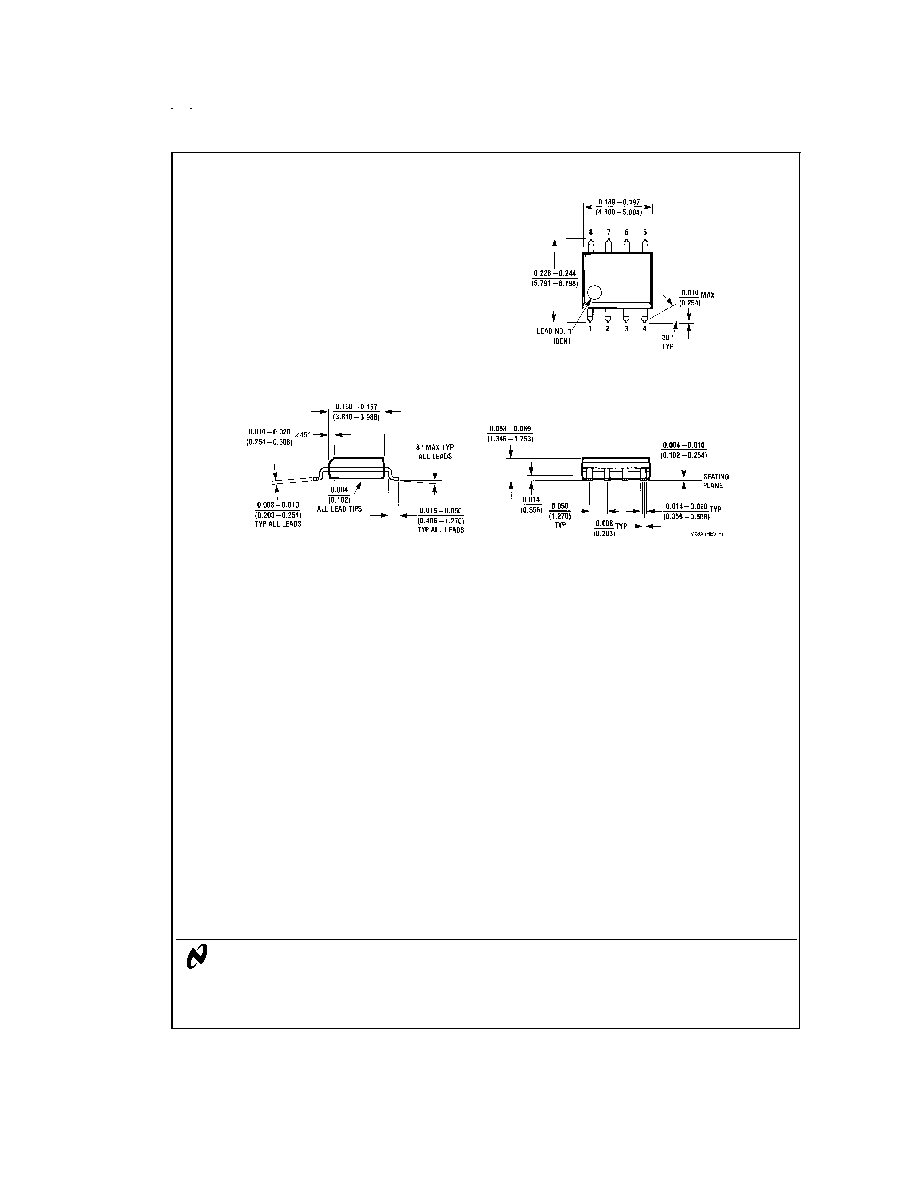
Physical Dimensions
inches (millimeters) unless otherwise noted
LIFE SUPPORT POLICY
NATIONAL'S PRODUCTS ARE NOT AUTHORIZED FOR USE AS CRITICAL COMPONENTS IN LIFE SUPPORT
DEVICES OR SYSTEMS WITHOUT THE EXPRESS WRITTEN APPROVAL OF THE PRESIDENT AND GENERAL
COUNSEL OF NATIONAL SEMICONDUCTOR CORPORATION. As used herein:
1. Life support devices or systems are devices or
systems which, (a) are intended for surgical implant
into the body, or (b) support or sustain life, and
whose failure to perform when properly used in
accordance with instructions for use provided in the
labeling, can be reasonably expected to result in a
significant injury to the user.
2. A critical component is any component of a life
support device or system whose failure to perform
can be reasonably expected to cause the failure of
the life support device or system, or to affect its
safety or effectiveness.
National Semiconductor
Corporation
Americas
Tel: 1-800-272-9959
Fax: 1-800-737-7018
Email: support@nsc.com
National Semiconductor
Europe
Fax: +49 (0) 1 80-530 85 86
Email: europe.support@nsc.com
Deutsch Tel: +49 (0) 1 80-530 85 85
English
Tel: +49 (0) 1 80-532 78 32
FranÁais Tel: +49 (0) 1 80-532 93 58
Italiano
Tel: +49 (0) 1 80-534 16 80
National Semiconductor
Asia Pacific Customer
Response Group
Tel: 65-2544466
Fax: 65-2504466
Email: sea.support@nsc.com
National Semiconductor
Japan Ltd.
Tel: 81-3-5639-7560
Fax: 81-3-5639-7507
www.national.com
8-Lead (0.150" Wide) Molded Small Outllne Package, JEDEC (M)
Order Number LM4861
NS Package Number M08A
LM4861
1.1W
Audio
Power
Amplifier
with
Shutdown
Mode
National does not assume any responsibility for use of any circuitry described, no circuit patent licenses are implied and National reserves the right at any time without notice to change said circuitry and specifications.







